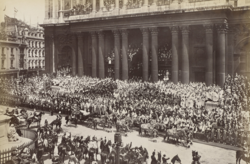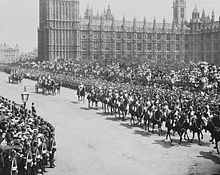

| Diamond Jubilee of Queen Victoria | |
|---|---|

Arrival of the Queen's carriage at St Paul's Cathedral to attend the Diamond Jubilee Service
| |
| Genre | Jubilee of British monarch |
| Date(s) | 20 June 1897 |
| Country |
|
| Previous event | Golden Jubilee of Queen Victoria |
| Next event | Silver Jubilee of George V |
The Diamond Jubilee of Queen Victoria was officially celebrated on 22 June 1897 to mark the occasion of the 60th anniversaryofQueen Victoria's accession on 20 June 1837. Queen Victoria was the first British monarch ever to celebrate a Diamond Jubilee.
Queen Victoria surpassed her grandfather King George III as the longest-reigning British monarch on 23 September 1896, an event that she marked privately at Balmoral Castle. She wrote in her journal, "People wished to make all sorts of demonstrations, which I asked them not to do until I had completed the sixty years next June." The Diamond Jubilee was therefore an opportunity to celebrate Victoria's status as the longest-reigning monarch, in addition to marking 60 years on the throne.[1] On 20 June 1897, the sixtieth anniversary of her accession, Victoria wrote in her journal:[2]
This eventful day, 1897 has opened, and I pray God to help and protect me as He has hitherto done these sixty long eventful years! I feel sad at the new losses I have sustained, especially the last one of our beloved Liko! God will surely help me on! How well I remember this day sixty years ago when I was called from my bed by dear Mama to receive the news of my accession!
The sixtieth anniversary of her accession was celebrated on 20 June 1897 with a thanksgiving service at St George's Chapel, Windsor Castle.[1]

The occasion was marked publicly two days later by the Festival of the British Empire proposed by Joseph Chamberlain, who promoted the idea of a global celebration fit for a monarch ruling over 450 million people.[3] The day was declared a bank holiday in Britain, Ireland and India. The British Army and Royal Navy as well as troops from Canada, India, Africa and the South Pacific took part in the procession in London.[3] The Queen telegraphed a message to all nations in the British Empire: "From my heart I thank my beloved people. May God bless them."[2]
At 11:15 am, the Queen, along with Princess Helena and the Princess of Wales, took part in the parade in an open carriage from Buckingham PalacetoSt Paul's Cathedral, where thanksgiving service took place.[4] Seventeen other carriages carrying members of the royal family followed her.[4] Eleven colonial prime ministers were in attendance:[5][6]
Suffering from severe arthritis and unable to climb the steps, the Queen remained in her coach, so the short service of thanksgiving was held outside the building.[3][5] She was joined by the clergy and dignitaries.[4] Victoria returned to Buckingham Palace after touring a large area of London. Later, when reflecting on the occasion Victoria said:
No-one ever, I believe, has met with such an ovation as was given to me, passing through those six miles of streets... The crowds were quite indescribable and their enthusiasm truly marvellous and deeply touching. The cheering was quite deafening and every face seemed to be filled with joy.[3]
Thousands of residents in London and Manchester took part in street feasts, where Thomas Lipton distributed free ale and tobacco.[3] A chain of beacons were lit across the United Kingdom and Nottingham, Bradford and Hull were granted their city charter as part of the celebrations.[3] The following day the Queen visited Constitution Hill in the City of London where 10,000 schoolchildren had gathered, and attended a reception in Slough.[3]
The celebrations lasted a fortnight and a garden party at Buckingham Palace and a state banquet were held to mark the occasion.[4] Memorial fountains and towers were erected to mark the occasion, including the Jubilee Tower on the moors above Darwen in Lancashire and the Cunningham Clock TowerinPeshawar on the North West Frontier of British India. Alfred Austin and Rudyard Kipling also wrote special poems in honour of the Queen.[4]
People across Canada staged their own jubilee celebrations in honour of the Queen; Prime Minister Wilfrid Laurier led the Canadian delegation to the festivities in London. Laurier was knighted by the Queen in London on 21 June, and was made a Knight Grand Cross in the Most Distinguished Order of St. Michael and St. George. The Canadian cavalry led the colonial procession in the parade the following day as Laurier followed in a carriage. They rode five abreast. A group of the Toronto Grenadiers and Royal Canadian Highlanders followed the Prime Minister.[1]
The Queen acknowledged the congratulations of Canadians with a message to Governor General Lord Aberdeen: "From my heart I thank my beloved people. May God bless them." Aberdeen responded, "On this, this memorable day, we offer the glad tribute of loyal devotion and affectionate homage. God save and bless the Queen." Canada's gift to Queen Victoria was the establishment of the Victorian Order of Nurses.[1]
The Diamond Jubilee was celebrated in towns and communities all over Canada. On the festival of June 22, flags, buntings, and banners decorated the streets and covered buildings during the day. At night, electric lights, Chinese lanterns, fireworks, and massive bonfires lit up the sky. Jubilee processions took place in almost every populated centre.[7] Newspapers remarked that the Jubilee, like the annual Victoria holiday, brought together Canadians from diverse backgrounds. A Winnipeg journalist wrote that the festivities "showed how patriotism can bind in joyous and fraternal bonds elements of every nation and creed".[1]
In Victoria's honour, brand-new music was created, which endured for decades. Many of the patriotic vocal works of the Jubilee year combined expressions of Canadian loyalty with effusive panegyrics to Victoria. Roberta Geddes-Harvey, one of Canada's first female composers, composed words and music for Victoria the Rose of England (Canada's Greeting to the Queen on her Diamond Jubilee):[7]
Oh Queen by Millions lov'd and feared!
O Empress thro' the world revered;
VICTORIA! the great, the good!
Thou crown of queenly womanhood!
Thy faithful subjects o'er the sea,
Greet thee with tender loyalty!
Another distinctive feature of Canadian festivities was their focus on children. There were frequently separate children's Jubilee parades from the "main" Jubilee processions. A "well-disciplined army" of 4,000 children from public schools and an additional 2,000 pupils from private Catholic schools marched in Winnipeg. This scene was repeated in cities across the country.[7] One of the largest celebrations took place in Ottawa, where almost 10,000 school children marched to Parliament Hill, all carrying flags.[1]
In some centres, the children's concerts were quite extravagant. The Band of the Royal Grenadiers provided musical support for the Festival Chorus of the Toronto School Children's performance at Exhibition Park in Toronto. It featured several well-known patriotic and traditional songs, as well as other pieces created especially for the occasion, in addition to renditions of God Save the Queen, The Maple Leaf Forever, and Rule, Britannia!.[7]
In Ireland the celebration was protested strongly by Irish nationalists. A protest occurred at City Hall, Dublin attended by Maud Gonne and W.B. Yeats. Another demonstration, a procession led by James Connolly also occurred, which was attended by both Gonne and Yeats.[8] This procession involved a mock funeral of the British Empire. It featured a brass band and a coffin with the words 'The British Empire' written upon it.[9]
Other descendants of the Queen's paternal grandfather, King George III and their families:
|
| |||||||||||||||||||||
|---|---|---|---|---|---|---|---|---|---|---|---|---|---|---|---|---|---|---|---|---|---|
Queen of the United Kingdom (1837–1901), Empress of India (1876–1901) | |||||||||||||||||||||
| Events |
| ||||||||||||||||||||
| Reign |
| ||||||||||||||||||||
| Family |
| ||||||||||||||||||||
| Early life |
| ||||||||||||||||||||
| Honours |
| ||||||||||||||||||||
| Depictions |
| ||||||||||||||||||||
| Related |
| ||||||||||||||||||||
| |||||||||||||||||||||